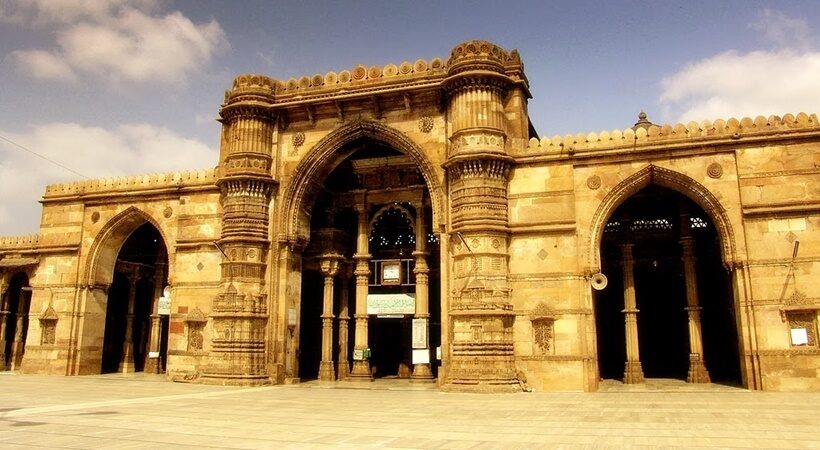A striking mosque commissioned by the founder of the city, Ahmed Shah I in 1424 is located near Bhadra Fort in the old walled city. This majestic mosque, which took around thirteen years to be completed, was established as a private shrine for the Gujarat Sultans. Construction started with its foundation being laid in the year 1411 and was completed in 1424. The mosque displays an elegant fusion of Hindu, Islamic, and Jain architectural elements and is unlike any other mosque in the Indian subcontinent.
The sacred complex features stunning architecture and is a comprehensive reflection of the Indo-Saracenic form of architecture. Set on a 75 metre long and 66-metre wide rectangular courtyard, it has three entrances. While the prayer hall occupies one side of the mosque the rest of the three sides are lined with a colonnade.
The two principal minarets flanking the arched central entrance to the mosque collapsed in the earthquake of 1819, but their lower portions survived. These exquisitely carved columns, remnants of the minarets, are one of the most striking features of the mosque. The designs carved on the columns are suggestive of elements of Hindu and Jain temple architecture. The mosque is also decorated with ornate jalis (latticed screens) carved in geometric and floral patterns. The fine blend of diverse architectural traditions of the mosque is perhaps most visible in the design of its immense main prayer hall with 260 columns, reminiscent of the interiors of Hindu and Jain temples.
Located in the heart of the old walled city of Ahmedabad, the Jama Masjid was an integral part of Sultan Ahmad Shah’s grand vision of establishing a new city by the river Sabarmati. Ahmad Shah I, formerly a deputy administrator for the Tughlaqs of the Delhi Sultanate, declared himself independent and established the Gujarat Sultanate along the west coast of India. He created the city of Ahmedabad in 1411 to serve as his new capital. The city flourished during his reign, the marks of its prosperity are evident in the stunning architecture dotting its landscape.
-masjid/Jama-(Jumma)-Masjid-1.jpg)
The mosque complex includes a vast paved courtyard with a large rectangular ablution tank positioned at its centre. The courtyard is collonaded on three sides with Arabic calligraphy in black adorning the walls, while the main prayer hall brings up the fourth side. The mosque also contains many syncretic elements that are not exactly obvious to the viewer: some of the central domes are carved like lotus flowers, closely related to the typical domes of Jain temples; and some of the pillars are carved with the form of a bell hanging on a chain, akin to the bells that often found hanging in Hindu temples.
The mosque is three-storied with balconies on the upper levels guarded against view by jalis. Within the sanctuary of the mosque, the qibla (the prayer wall) is also decorated with intricately carved screens. The portico of the Jama Masjid is what sets it apart from other mosques in India, with its crop of pillars dividing the space into 15 bays and transforming the place into a playground of light and shadows.



















